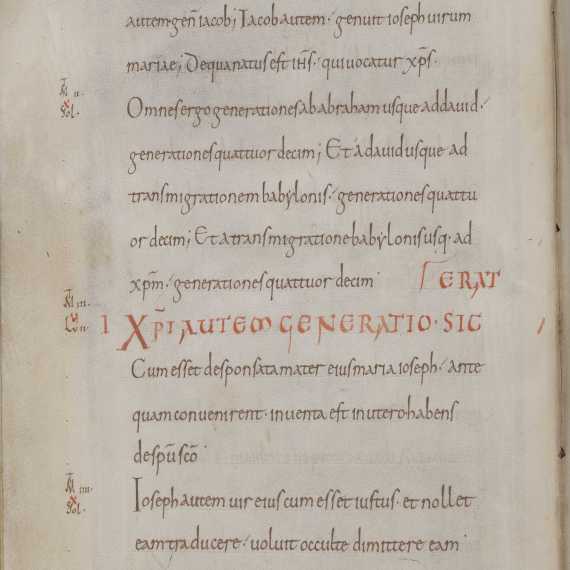John Zachariah Shuster studies reception history of the Bible at the Hebrew University of Jerusalem. This post is the first of a series of three exploring the tools built into biblical manuscripts to help their medieval users find their way around.
Herzog August Bibliothek, MS Cod. Guelf. 84.3 Aug. 2° is a neat, legible codex containing the four gospels. This manuscript includes thirteen ornate pages of tables. If you flip through the text, you will notice that the roman numerals in the tables correspond to numerals in the margins of the gospel texts. However, as tidy as they are, the tables of contents can be confusing, as can the marginalia.

What if we wanted to locate the story of Jesus feeding the multitude in Matthew 15:32-39? Today we rely on search engines to find our way around the internet, but when we work with a manuscript, we rarely have such a convenient tool. Finding a text in a manuscript can be surprisingly time-consuming. To locate a text, we often rely on the original table of contents in the manuscript.
The trouble is that medieval tables are not always easy to read. In any given text, one might find a variety of pointers: in-line rubrics, breviaries, liturgical calendars, a host of verse-and-chapter systems, Eusebian Canons, or large historiated initials calling for our attention (and admiration).
Before we can use the tables to help us navigate, we must first identify their rules. Let us take a closer look at the tables. On fol. 7r, the first page of the tables, we read the heading “CANON PRIMUS IN QUO IIII,” or “First Canon in which four.” Four whats? A good guess would be four gospels; we’re presented with four columns, each labelled with its respective gospel writer.

Looking in (between) the columns, we see lists of numbers, carefully aligned by drypoint ruling.
On the next page, fol. 7v, we see the same title as before. The generally growing numbers seem to indicate a continuation of fol. 7r.

The bottom of fol. 7v reads “FINIT CANON PRIMUS,” or “the end of the first canon.” And, indeed, on the next page, fol. 8r, the title reads: “CANON II IN QUO III,” or “the second canon in which three.” “Three” refers to three gospels, for fol. 8r only has three columns: Matthew, Mark, and Luke—no John this time.

In this pattern, we discover ten canons, each presenting a different combination of the gospels.
To better understand what’s going on in these tables, let us take a look at the marginalia found in the text. The text of Matthew begins on fol. 19v with two decorated initials reading “Liber,” the first word of the Vulgate Matthew.

Further into the text, on 20v, we see a progression of tiny marginal notes:

The “M” with a “T” above it means “Matthew,” and the “L” with a “u” next to it means “Luke.” The first marginal note reads: “Matthew II. X Only.” The red “X” refers to Canon X. Canon X starts on fol. 11v, where we find the title: “CANON X IN QUO MAT SOLUS,” or “Canon X, in which Matthew alone.” The first number listed is “II,” the very number we are given in this marginal note. The “II” is not matched with any other number, which fits a number marked “Solus.”
The next marginal note reads “Matthew III. V Luke II.” The “V” refers to Canon V. “CANON V, IN QUO II” occupies fol. 10v. It presents numbers from Matthew and Luke. The first entry for Matthew is “III,” and the first entry for Luke (at the bottom left of the page) is “II.” Presto! Somehow, it seems, “Matthew III” matches with “Luke II,” according to Canon V.
What, then, do these numerals mean? They are part of the Eusebian Canons, an ancient system of gospel parallels. The anecdotes and sayings in each gospel are assigned a numeral, and the Eusebian Canons match these numerals to show where the parallel for one story is found in the various gospels. Today we have many apparatuses that perform this service, such as Burton Throckmorton Jr.’s Gospel Parallels. But unless we are familiar with the story behind every numeral of the Eusebian Canons, these beautiful tables will not be of much use to us in finding Matthew 15:32-39.
We did not find a useful tool for navigating the manuscript in the canons, but that’s research for you! Still want to learn a practical way to find passages in the manuscript? Tune in for my next post in which (pinky promise) I will show you a workable method.
John Zachariah Shuster, Hebrew University of Jerusalem
License information:
Herzog August Bibliothek Wolfenbüttel
Herzog August Bibliothek Wolfenbüttel Terms of Use (CC BY-SA)

3 Replies to “Navigating Biblical Manuscripts 1: Eusebian Canons”